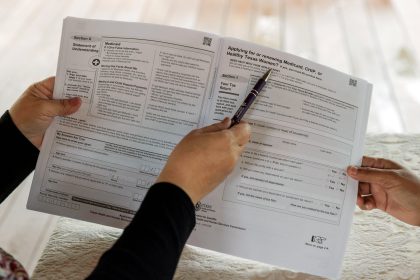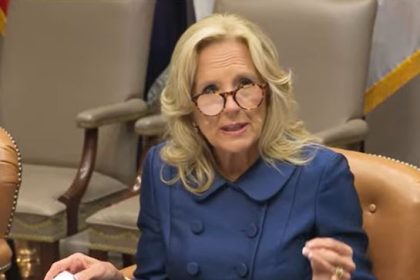FEMA Report: Flood Insurance Hikes Will Drive 1M From Market

ST. LOUIS (AP) — When questioned by members of Congress, the Federal Emergency Management Agency said its new update to the nation’s flood insurance program will prompt more people to sign up for coverage, even though many will pay more for it.
But in a FEMA report obtained by The Associated Press under the Freedom of Information Act, the agency estimates 1 million fewer Americans will buy flood insurance by the end of the decade — a sizable number of people at risk of catastrophic financial loss.
As climate change drives increased flood risk in many parts of the country, FEMA has updated its flood insurance program to more accurately reflect risk, but also make the program more solvent. It’s a response in part to criticism that taxpayers were funding big payouts when coastal mansions in risky locations flooded.
But nine senators from both parties expressed “serious concerns” about the new pricing system in a letter last September, after hearing that the agency’s internal numbers predicted policies would drop off by 20%. The next month FEMA told the AP those figures were “misleading” and “taken out of context” and that on the subject of how many people will be insured “there is no study or report to share.”
The agency painted a different picture however at the end of the year when it sent a report to the treasury secretary and a handful of congressional leaders saying higher prices would drive a fall off of 1 million policies compared to the beginning of the decade.
The issue of how many people go uninsured for flooding is vital, said Chad Berginnis, executive director of the Association of State Floodplain Managers.
“We are talking the basic economic health, I think of not only our households and businesses, but our communities at large,” if fewer people buy flood insurance, he said.
The federal flood insurance program was started when many private insurers stopped offering policies in high-risk areas. It operates in the red, paying out more in claims than it collects in premiums. By more accurately setting rates, the update, officially referred to as Risk Rating 2.0, makes it more expensive to develop in flood-prone regions, shifting the risks of disaster towards those homeowners.
Risk Rating 2.0 will factor in a property’s unique flood risk — like its distance to water and cost to rebuild. The old system was based largely on a home’s elevation and whether it was in a designed flood zone. Most policy holders will now see their rates go up. But for the first time, nearly a quarter of policyholders will see theirs go down. Buyers of new policies began seeing the new prices in October.
FEMA downplayed the report obtained by the AP as a pessimistic projection, aimed at forecasting finances, not insurance participation. The agency said it has not directly studied how many people will buy flood insurance.
“There’s numerous reasons that growth could occur as time goes on,” said David Maurstad, a senior executive of the National Flood Insurance Program, adding that an enrollment analysis should consider the agency’s marketing efforts, the program’s clear messaging of flood risk, price decreases and other factors.
But critics like Sen. Bob Menendez, D-N.J., said affordability is a problem and FEMA didn’t disclose the impact of those higher costs.
“This report makes it crystal clear that FEMA failed to be transparent with policyholders, Congress, and ultimately the American public,” Menendez said in a statement. It shouldn’t have taken a records request for details to emerge, he said.
When Francisca Acuña, a climate and community activist in Austin, Texas, was given a new quote, it was hard for her to believe.
“I go, ‘no, you’re making a mistake,’” she said.
Acuña had previously paid $446 a year. Under Risk Rating 2.0, she was quoted $1,893. Rate increases that large are rare. Increases are generally capped at 18% a year, but Acuña, juggling other expenses, had let her policy lapse so she was required to pay the full amount right away.
“There’s no way, no how, that I can afford it,” Acuña said.
Told of Acuña’s situation, Maurstad said the rates reflect actual risk. It’s unfortunate when people face big increases, but ensuring the financial health of the program and accurate rates, is “good public policy,” he said.
Jim Rollo, a New York-based insurance agent, said he’s seeing a change in some buyer attitudes. Some seem more skeptical about properties that have previously flooded and have higher premiums. Others “roll the dice” and forego costly insurance if it’s not required.
“We are writing fewer policies than we were before,” Rollo said.
Congress should create an affordability program for people struggling to buy insurance and fund efforts to improve flood protections, said Joel Scata, a lawyer at the Natural Resources Defense Council, an environmental advocacy group.
But Maurstad said FEMA’s mission is different from the private sector. FEMA must help people “before, during and after” disasters as well as charge premiums that are risk-based and financially sound.
“We have certain responsibilities we are charged with. The number of policies sold isn’t one of them, again, because we are a government program,” he said.
Nevertheless the agency report predicts that the program, even with higher revenue, will continue to sink deeper into debt.
___
The Associated Press receives support from the Walton Family Foundation for coverage of water and environmental policy. The AP is solely responsible for all content. For all of AP’s environmental coverage, visit https://apnews.com/hub/climate-and-environment
























